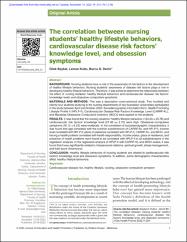| dc.contributor.author | Baykal, Dilek | |
| dc.contributor.author | Kutlu, Leman | |
| dc.contributor.author | Demir, Burcu D. | |
| dc.date.accessioned | 2022-11-15T13:25:04Z | |
| dc.date.available | 2022-11-15T13:25:04Z | |
| dc.date.issued | 2022 | en_US |
| dc.identifier.citation | Baykal, D., Kutlu, L., & Demir, B. (2022). The correlation between nursing students’ healthy lifestyle behaviors, cardiovascular disease risk factors’ knowledge level, and obsession symptoms. Journal of Education and Health Promotion, 11(1), 281. https://doi.org/10.4103/jehp.jehp_902_21
| en_US |
| dc.identifier.issn | 2277-9531 | |
| dc.identifier.issn | 2319-6440 | |
| dc.identifier.uri | WOS:000877898400034 | |
| dc.identifier.uri | PubMed ID: 36325215 | |
| dc.identifier.uri | https://hdl.handle.net/20.500.12900/102 | |
| dc.description.abstract | BACKGROUND: Nursing students have a role in the awareness of risk factors in the development
of healthy lifestyle behaviors. Nursing students’ awareness of disease risk factors plays a role in
developing healthy lifestyle behaviors. Therefore, it was aimed to determine the relationship between
the effect of nursing students’ healthy lifestyle behaviors and cardiovascular disease risk factors’
knowledge levels and obsessive–compulsive symptoms.
MATERIALS AND METHODS: This was a descriptive cross‑sectional study. Two hundred and
twenty‑four students studying in the nursing departments of two foundation universities participated
in the study between April and October 2020. Sociodemographic information form, Health Promoting
Lifestyle Profile II (HPLP‑II), Cardiovascular Disease Risk Factors Knowledge Level (CARRF‑KL),
and Maudsley Obsessive–Compulsive Inventory (MOCI) were applied to the students.
RESULTS: It was found that the nursing students’ healthy lifestyle behaviors (123.53 ± 25.78) and
cardiovascular risk factors’ knowledge level (21.08 ±± 2.70) were high. Obsessive–compulsive
symptoms (16.12 ± 6.22) were moderate. In the correlation of sociodemographic characteristics, it
was found that age correlated with the nutrition subdimension of CARRF‑KL and HPLP‑II, income
level correlated with HPLP‑II, place of residence correlated with HPLP‑II, CARRF‑KL, and MOCI, and
having a health problem correlated with health responsibility. Income status, place of residence, and
presence of health problems were found to be correlated with HPLP‑II in all subdimensions in the
regression analysis. In the regression analysis of HPLP‑II with CARRF‑KL and MOCI scales, it was
found that it was significantly related to interpersonal relations, spiritual growth, stress management,
and total score dimensions.
CONCLUSION: Healthy lifestyle behaviors of nursing students are related to cardiovascular risk
factors’ knowledge level and obsession symptoms. In addition, some demographic characteristics
affect healthy lifestyle behaviors. | en_US |
| dc.language.iso | eng | en_US |
| dc.publisher | Medknow Publications | en_US |
| dc.relation.isversionof | 10.4103/jehp.jehp_902_21 | en_US |
| dc.rights | info:eu-repo/semantics/openAccess | en_US |
| dc.subject | Cardiovascular disease risk | en_US |
| dc.subject | Healthy lifestyle | en_US |
| dc.subject | Nursing | en_US |
| dc.subject | Obsessive | en_US |
| dc.subject | Compulsive symptom | en_US |
| dc.title | The correlation between nursing students' healthy lifestyle behaviors, cardiovascular disease risk factors' knowledge level, and obsession symptoms | en_US |
| dc.type | article | en_US |
| dc.department | İstanbul Atlas Üniversitesi, Sağlık Bilimleri Fakültesi, Hemşirelik Bölümü | en_US |
| dc.authorid | Dilek Baykal / 0000-0001-5965-9318 | en_US |
| dc.authorid | Leman Kutlu / 0000-0001-6393-8328 | en_US |
| dc.contributor.institutionauthor | Kutlu, Leman | |
| dc.contributor.institutionauthor | Baykal, Dilek | |
| dc.identifier.volume | 11 | en_US |
| dc.identifier.issue | 1 | en_US |
| dc.identifier.startpage | 1 | en_US |
| dc.identifier.endpage | 8 | en_US |
| dc.relation.journal | Journal of Education and Health Promotion | en_US |
| dc.relation.publicationcategory | Makale - Uluslararası Hakemli Dergi - Kurum Öğretim Elemanı | en_US |

















